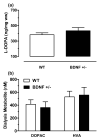Aberrant striatal dopamine transmitter dynamics in brain-derived neurotrophic factor-deficient mice
- PMID: 21988371
- PMCID: PMC3385875
- DOI: 10.1111/j.1471-4159.2011.07531.x
Aberrant striatal dopamine transmitter dynamics in brain-derived neurotrophic factor-deficient mice
Abstract
Brain-derived neurotrophic factor (BDNF) modulates the synaptic transmission of several monoaminergic neuronal systems, including forebrain dopamine-containing neurons. Recent evidence shows a strong correlation between neuropsychiatric disorders and BDNF hypofunction. The aim of the present study was to characterize the effect of low endogenous levels of BDNF on dopamine system function in the caudate-putamen using heterozygous BDNF (BDNF(+/-) ) mice. Apparent extracellular dopamine levels in the caudate-putamen, determined by quantitative microdialysis, were significantly elevated in BDNF(+/-) mice compared with wildtype controls (12 vs. 5 nM, respectively). BDNF(+/-) mice also had a potentiated increase in dopamine levels following potassium (120 mM)-stimulation (10-fold) relative to wildtype controls (6-fold). Slice fast-scan cyclic voltammetry revealed that BDNF(+/-) mice had reductions in both electrically evoked dopamine release and dopamine uptake rates in the caudate-putamen. Superfusion of BDNF led to partial recovery of the electrically stimulated dopamine release response in BDNF(+/-) mice. Conversely, tissue accumulation of L-3,4-dihydroxyphenylalanine, extracellular levels of dopamine metabolites, and spontaneous locomotor activity were unaltered. Together, this study indicates that endogenous BDNF influences dopamine system homeostasis by regulating the release and uptake dynamics of pre-synaptic dopamine transmission.
© 2011 The Authors. Journal of Neurochemistry © 2011 International Society for Neurochemistry.
Figures





References
-
- Altar CA, Cai N, Bliven T, Juhasz M, Conner JM, Acheson AL, Lindsay RM, Wiegand SJ. Anterograde transport of brain-derived neurotrophic factor and its role in the brain. Nature. 1997;389:856–860. - PubMed
-
- Altar CA, Siuciak JA, Wright P, Ip NY, Lindsay RM, Wiegand SJ. In situ hybridization of trkB and trkC receptor mRNA in rat forebrain and association with high-affinity binding of [125I]BDNF, [125I]NT-4/5 and [125I]NT-3. Eur J Neurosci. 1994;6:1389–1405. - PubMed
-
- Beck KD, Knusel B, Hefti F. The nature of the trophic action of brain-derived neurotrophic factor, des(1-3)-insulin-like growth factor-1, and basic fibroblast growth factor on mesencephalic dopaminergic neurons developing in culture. Neuroscience. 1993;52:855–866. - PubMed
Publication types
MeSH terms
Substances
Grants and funding
LinkOut - more resources
Full Text Sources
Other Literature Sources
Molecular Biology Databases

